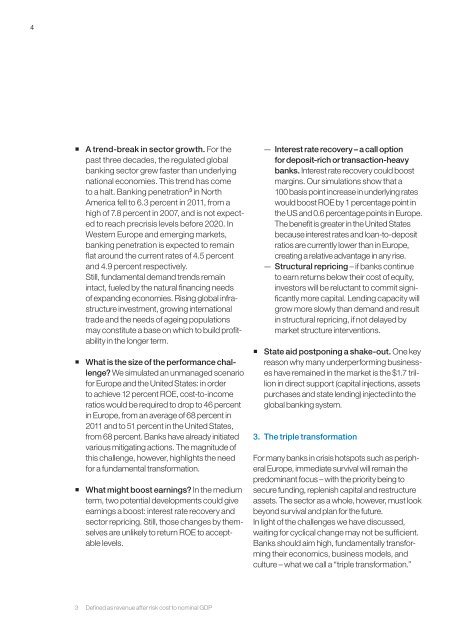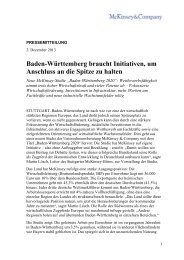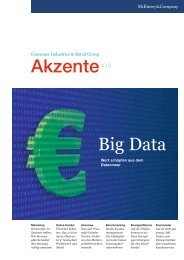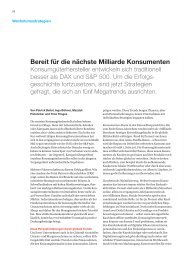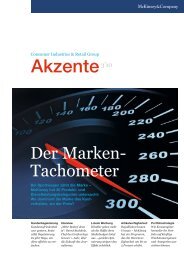The triple transformation - McKinsey & Company
The triple transformation - McKinsey & Company
The triple transformation - McKinsey & Company
You also want an ePaper? Increase the reach of your titles
YUMPU automatically turns print PDFs into web optimized ePapers that Google loves.
4<br />
A trendbreak in sector growth. For the<br />
past three decades, the regulated global<br />
bank ing sector grew faster than under lying<br />
na tion al economies. This trend has come<br />
to a halt. Banking penetration 3 in North<br />
America fell to 6.3 percent in 2011, from a<br />
high of 7.8 percent in 2007, and is not expected<br />
to reach precrisis levels before 2020. In<br />
Western Europe and emerging markets,<br />
banking penetration is expected to remain<br />
flat around the current rates of 4.5 per cent<br />
and 4.9 per cent respectively.<br />
Still, fundamental demand trends remain<br />
intact, fueled by the natural financing needs<br />
of expanding economies. Rising global infrastructure<br />
investment, growing international<br />
trade and the needs of ageing populations<br />
may constitute a base on which to build profitability<br />
in the longer term.<br />
What is the size of the performance challenge?<br />
We simulated an unmanaged sce nario<br />
for Europe and the United States: in order<br />
to achieve 12 percent ROE, costtoincome<br />
ratios would be required to drop to 46 percent<br />
in Europe, from an average of 68 percent in<br />
2011 and to 51 percent in the United States,<br />
from 68 percent. Banks have already initiated<br />
var i ous mitigating actions. <strong>The</strong> magnitude of<br />
this challenge, however, highlights the need<br />
for a fundamental <strong>transformation</strong>.<br />
What might boost earnings? In the medium<br />
term, two potential developments could give<br />
earnings a boost: interest rate recovery and<br />
sector repricing. Still, those changes by themselves<br />
are unlikely to return ROE to acceptable<br />
levels.<br />
3 Defined as revenue after risk cost to nominal GDP<br />
— Interest rate recovery – a call option<br />
for depositrich or transactionheavy<br />
banks. Interest rate recovery could boost<br />
margins. Our simulations show that a<br />
100 basis point increase in underlying rates<br />
would boost ROE by 1 percentage point in<br />
the US and 0.6 percentage points in Europe.<br />
<strong>The</strong> benefit is greater in the United States<br />
because interest rates and loantodeposit<br />
ratios are currently lower than in Europe,<br />
creating a relative advantage in any rise.<br />
— Structural repricing – if banks continue<br />
to earn returns below their cost of equity,<br />
investors will be reluctant to commit sig nifi<br />
cantly more capital. Lending capacity will<br />
grow more slowly than demand and result<br />
in structural repricing, if not delayed by<br />
market structure interventions.<br />
State aid postponing a shakeout. One key<br />
reason why many underperforming businesses<br />
have remained in the market is the $1.7 trillion<br />
in direct support (capital injections, assets<br />
purchases and state lend ing) injected into the<br />
global banking system.<br />
3. <strong>The</strong> <strong>triple</strong> <strong>transformation</strong><br />
For many banks in crisis hotspots such as pe ripheral<br />
Europe, immediate survival will remain the<br />
pre dominant focus – with the priority being to<br />
secure funding, replenish capital and restructure<br />
assets. <strong>The</strong> sector as a whole, however, must look<br />
beyond survival and plan for the future.<br />
In light of the challenges we have discussed,<br />
waiting for cyclical change may not be sufficient.<br />
Banks should aim high, fundamentally trans forming<br />
their economics, business models, and<br />
cul ture – what we call a “<strong>triple</strong> <strong>transformation</strong>.”


